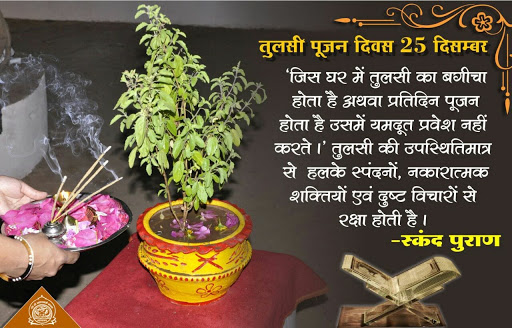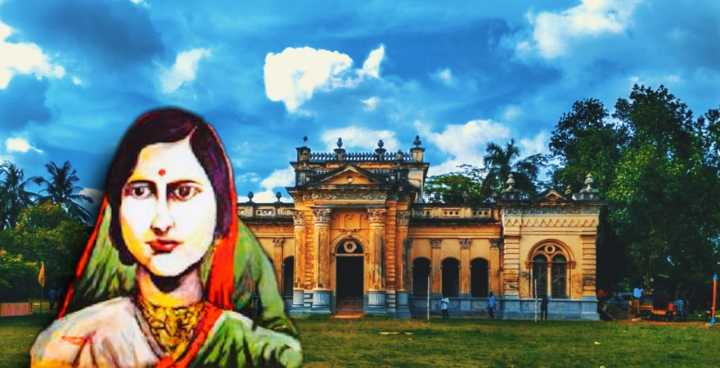
🌺💞🚩हिंदूधर्म में तुलसी पूजन की परंपरा पौराणिक काल से चली आ रही है। लेकिन पिछले कुछ वर्षों से भारत में 25 दिसंबर को तुलसी पूजन दिवस मनाया जाता है। इसकी शुरुआत साल 2014 से हुई और इस दौरान देश के कई केंद्रीय मंत्रियों और...
#तुलसी_पूजन_दिवस
#तुलसी_पूजन_दिवस

..संतों ने तुलसी पूजा के महत्व का बखान सोशल मीडिया के द्वारा किया।
तभी से 25 दिसंबर को तुलसी पूजन दिवस मनाया जाने लगा।
-तुलसी पूजन से बुरे विचार नष्ट होते हैं।
-मान्यता है कि तुलसी के पौधे के पास किसी भी मंत्र-स्तोत्र का पाठ करने से उसका कई गुना फल मिलता है।
#तुलसी_पूजन_दिवस
तभी से 25 दिसंबर को तुलसी पूजन दिवस मनाया जाने लगा।
-तुलसी पूजन से बुरे विचार नष्ट होते हैं।
-मान्यता है कि तुलसी के पौधे के पास किसी भी मंत्र-स्तोत्र का पाठ करने से उसका कई गुना फल मिलता है।
#तुलसी_पूजन_दिवस

-भूत,प्रेत, पिशाच, ब्रह्मराक्षस,दैत्य आदि सब तुलसी के पौधे से दूर भागते हैं।
-पद्मपुराण के अनुसार तुलसी पत्ते से टपकता हुआ जल यदि मनुष्य अपने सिर पर लगाता है तो इतना करने भर से उस मनुष्य को गंगास्नान और 10 गोदान का फल मिल जाता है।
#तुलसी_पूजन_दिवस
-पद्मपुराण के अनुसार तुलसी पत्ते से टपकता हुआ जल यदि मनुष्य अपने सिर पर लगाता है तो इतना करने भर से उस मनुष्य को गंगास्नान और 10 गोदान का फल मिल जाता है।
#तुलसी_पूजन_दिवस

-तुलसी पूजन से रोग नष्ट हो जाते हैं और अच्छा स्वास्थ्य प्राप्त होता है।
-तुलसी पूजन,तुलसी रोपण व तुलसी धारण से पाप नष्ट होते हैं।
-तुलसी पूजन स्वर्ग व मोक्ष के द्वार खोलता है।
#तुलसी_पूजन_दिवस
-तुलसी पूजन,तुलसी रोपण व तुलसी धारण से पाप नष्ट होते हैं।
-तुलसी पूजन स्वर्ग व मोक्ष के द्वार खोलता है।
#तुलसी_पूजन_दिवस

-श्राद्ध व यज्ञ आदि कार्यों में तुलसी का एक पत्ता भी महान पुण्य देनेवाला होता है।
-तुलसी के नाम उच्चारण मात्र से पुण्य प्राप्ति होती है।मनुष्य के सारे पाप नष्ट हो जाते हैं
#तुलसी_पूजन_दिवस
-तुलसी के नाम उच्चारण मात्र से पुण्य प्राप्ति होती है।मनुष्य के सारे पाप नष्ट हो जाते हैं
#तुलसी_पूजन_दिवस
आपने गौर किया होगा तो ऐसा जरूर देखा होगा कि कई बार तुलसी के पौधे को चाहे कितना भी पानी दे दें और देखभाल कर लें, लेकिन पौधा अचानक मुरझाने लगता है। धार्मिक मान्यता कि बात करें तो यह परिवार पर किसी तरह का संकट आने की संभावना की ओर ईशारा करता है।
शास्त्रों में ऐसा भी कहा गया है कि यदि घर-परिवार पर कोई संकट आने वाला होता है तो सबसे पहले उस घर से लक्ष्मी यानि तुलसी चली जाती है और वहां दरिद्रता आने लगती है।
• • •
Missing some Tweet in this thread? You can try to
force a refresh























